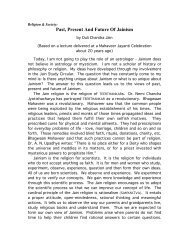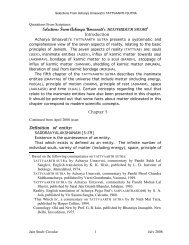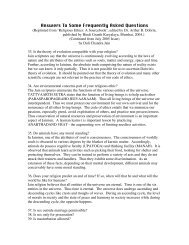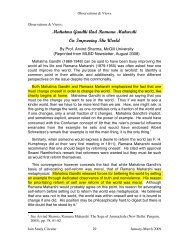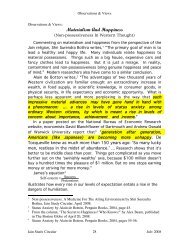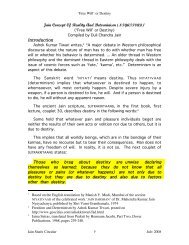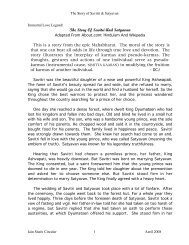Link to Complete Article - The Jain Study Circle
Link to Complete Article - The Jain Study Circle
Link to Complete Article - The Jain Study Circle
You also want an ePaper? Increase the reach of your titles
YUMPU automatically turns print PDFs into web optimized ePapers that Google loves.
Selections From Acharya Umasvati’s TATTVAARTH SUTRA<br />
Quotations From Scriptures:<br />
Selections From Acharya Umasvati’s TATTVAARTH SUTRA 1<br />
Introduction<br />
Acharya Umasvati’s TATTVAARTH SUTRA presents a systematic and<br />
comprehensive view of the seven aspects of reality, relating <strong>to</strong> the basic<br />
principles of <strong>Jain</strong>ism. <strong>The</strong> first five chapters essentially deal with the first<br />
two aspects of reality, souls (JEEV) and matter (PUDGAL). <strong>The</strong> third aspect<br />
of reality, influx of karmic matter <strong>to</strong>ward soul (AASRAV), is the subject of<br />
the sixth and seventh chapters. <strong>The</strong> eighth chapter describes the<br />
bondage of karmas.<br />
Chapter 8. Bondage Of Karmas<br />
Features of Bondage<br />
Causes of bondage:<br />
MITHYAADARSHANAAVIRATIPRAMAADAKASHAAYAYOGAA BANDHAHETAVAH [8-1]<br />
Causes of bondage of karma are irrational perception<br />
(MITHYAADARSHAN), disregard of vows (AVIRATI), indolence (PRAMAAD),<br />
passions (KASHAAYA) and the activities of body, speech and mind<br />
(YOGA).<br />
Irrational perception denotes harboring deluding concepts. Disregard<br />
of vows subsumes lack of restraint. Indolence is lack of<br />
conscientiousness. Passions connote emotions involving anger, pride,<br />
intrigue and greed. Physical, verbal and mental activities comprise YOGA.<br />
<strong>The</strong>se five fac<strong>to</strong>rs lead <strong>to</strong> karmic bondage.<br />
Rational perception implies belief in things and events as ascertained<br />
through unbiased study and logical thinking. Thus, irrational perception<br />
means belief in concepts that are illogical and contrary <strong>to</strong> one’s<br />
1<br />
Based on the following commentaries on TATTVAARTH SUTRA:<br />
TATTVAARTH SUTRA by Acharya Umasvati, commentary by Pandit Sukh Lal Sanghvi,<br />
English translation by K. K. Dixit, published by L. D. Institute of Indology,<br />
Ahmedabad, 1974.<br />
TATTVAARTH SUTRA by Acharya Umasvati, commentary by Pandit Phool Chandra<br />
Siddhantacharya, published by Varni Granthmala, Varanasi, 1949.<br />
TATTVAARTH SUTRA by Acharya Umasvati, commentary by Pandit Mohan Lal Shastri,<br />
published by Saral <strong>Jain</strong> Granth Bhandar, Jabalpur, 1983.<br />
Reality, English translation of Acharya Pujya Pad’s SARVAARTHASIDDHI by S. A. <strong>Jain</strong>,<br />
published by Vir Sasana Sangha, Calcutta, 1960.<br />
‘That Which Is’, a commentary on TATTVAARTH SUTRA by Dr Nath Mal Tatia,<br />
published by Harper Collins, 1994.<br />
MOKSHASHASTRA, VIMAL PRASHNOTTARI TEEKA by Aaryika Syaadavaadamati,<br />
published by Bharatavarsheeya Anekaant Vidvat Parishad, 2004.<br />
<strong>Jain</strong> <strong>Study</strong> Circular 1<br />
Oc<strong>to</strong>ber-December 2009
Selections From Acharya Umasvati’s TATTVAARTH SUTRA<br />
observation, study and common sense. Rational perception is of two<br />
types: Instinctive (NISARGAJ), which is achieved through intuition, and<br />
cogitated (ADHIGAMAJ) that is secured through reasoned knowledge.<br />
Similarly, irrational perception is of two types. <strong>The</strong> first type of irrational<br />
perception is intuitive or natural - originating through intuition (AGRAHEET).<br />
<strong>The</strong> second one is acquired or engendered (GRAHEET) through interaction<br />
with illogical individuals and study of fallacious texts. Evidently, acquired<br />
irrational perception does not involve logical and unbiased thinking. It<br />
should be pointed out that instrumental (NIMITTA) cause of the intuitive<br />
rational perception is fruition of perception-deluding karma. Fallacious<br />
texts and illogical sermons coupled with imprudent and indiscreet<br />
acceptance of concepts, which constitute pseudo-karmas, serve as the<br />
instrumental causes for the acquired irrational perception.<br />
Another interesting classification of irrational perception is as follows:<br />
Absolutism (EKAANT): Absolutism implies having a one-sided viewpoint.<br />
An entity possesses multiple attributes and so one has <strong>to</strong> investigate<br />
a given concept or phenomenon from a number of viewpoints. For<br />
example, all entities of the universe undergo transformations, while<br />
the basic substances remain unchanged. When water evaporates,<br />
the liquid state vanishes and the vapor state is formed. However,<br />
each molecule of water still has two a<strong>to</strong>ms of hydrogen and one<br />
a<strong>to</strong>m of oxygen. In this process, the substance water remains<br />
unchanged while its state is changed from liquid <strong>to</strong> vapor.<br />
Absolutism involves holding the views such as everything is transient<br />
or all is permanent. Because of absolutism, some individuals refrain<br />
from studying the scriptures and concepts of religions other than<br />
their own. Such views and tendencies comprise irrational perception.<br />
Perversion (VIPAREET): Perversion entails being stubbornly opposite <strong>to</strong><br />
what is good and proper. It is deviation from norms of decency and<br />
believing in what is contrary <strong>to</strong> one’s common sense. In essence, it<br />
involves adopting concepts indiscriminately and promiscuously.<br />
Skepticism (SAMSHAYA): An individual is expected <strong>to</strong> develop and<br />
ascertain one’s concept of reality, nature of things, through judicious<br />
observation, study and contemplation. Further, one keeps in mind<br />
that one’s concepts might be refined through further study and<br />
experience. Skepticism means doubts about one’s beliefs and lack of<br />
confidence in one’s intellect and judgment. Such indecisiveness is an<br />
aspect of irrational perception.<br />
<strong>Jain</strong> <strong>Study</strong> Circular 2<br />
Oc<strong>to</strong>ber-December 2009
Selections From Acharya Umasvati’s TATTVAARTH SUTRA<br />
Egalitarianism (VAINAYIK): Egalitarianism is a virtue characterized by the<br />
belief that all men should have equal rights and that views of each<br />
individual should be treated with respect (VINAYA). In this respect,<br />
egalitarianism is desirable. However, out of respect for a religious<br />
personality and/or scripture, an individual may embrace a variety of<br />
discordant concepts with a non-discriminating attitude, may lose<br />
his/her sense of direction and essentially indulge in blind faith.<br />
Evidently, this represents irrational perception, causing the influx of<br />
karmas.<br />
Ignorance (AJNAAN): Ignorance is not being able <strong>to</strong> discriminate between<br />
desirable and undesirable for the self. Obviously, it is an unwelcome<br />
trait. <strong>Jain</strong>ism emphasizes that rational perception and rational<br />
knowledge must precede rational conduct - auspicious activities for<br />
uplift of the self. <strong>The</strong>refore, one should secure knowledge of the<br />
various aspects of one’s worldly existence. Those who have<br />
irrational perception desist from such endeavor.<br />
It should be pointed out that there is very fine line between desirable<br />
and undesirable aspects. For example, egalitarianism is a virtue for most<br />
part but a little indiscretion turns it in<strong>to</strong> irrational perception.<br />
Disregard of vows (lack of restraint or non-abstinence) leads <strong>to</strong><br />
intemperance and overindulgence in sensual pleasures. It brings about<br />
influx of karmas. Non-abstinence has twelve aspects, relating <strong>to</strong> six<br />
classes of worldly beings and six senses. Six classes of worldly beings<br />
include five types of one-sensed living beings that are immobile<br />
(STHAAVAR) and mobile (TRAS) beings. Six senses include the sense of<br />
<strong>to</strong>uch, taste, smell, sight, hearing and mental faculty. Abstinence entails<br />
avoiding or minimizing violence of the six classes of living beings and<br />
tempering the pursuit of pleasures of the six senses.<br />
Indolence can be defined as disregard for one’s needs and obligations.<br />
<strong>Jain</strong>ism is the religion of self-reliance. Thus each individual soul is<br />
responsible for its destiny, which can be served through self-endeavor.<br />
As a consequence, apathy and lethargy leads <strong>to</strong> karmic influx that<br />
perpetuates the worldly existence of soul. Scriptures describe fifteen<br />
kinds of indolence: related <strong>to</strong> four kinds of perverting s<strong>to</strong>ries, four<br />
passions, five senses, stupor and infatuation.<br />
Passions of anger, pride, intrigue and greed malign the righteous<br />
qualities of a living being. <strong>The</strong>y debase an individual’s mental state.<br />
Further, they poison his/her animate and inanimate surroundings.<br />
<strong>Jain</strong> <strong>Study</strong> Circular 3<br />
Oc<strong>to</strong>ber-December 2009
Selections From Acharya Umasvati’s TATTVAARTH SUTRA<br />
<strong>The</strong> four passions are anger, pride, intrigue and greed. Each one of<br />
these can have four gradations (degrees): incessant (ANANTAANUBANDHI<br />
ingrained from limitless times, extremely intense, like a line drawn on<br />
s<strong>to</strong>ne) that leads <strong>to</strong> spiritual stupefaction; minor-vows-impeding<br />
(APRATYAAKHYAAN less intense, like a line drawn on wood) that prevents<br />
adoption of partial vows (householder's conduct); major-vows-impeding<br />
(PRATYAAKHYAAN like a line drawn in sand) that prevents adoption of <strong>to</strong>tal<br />
vows (monk's conduct); and mild (SAMJVALAN very mild, like a line on<br />
water) that generates unconscious attachment <strong>to</strong> life in monks. Thus<br />
there are sixteen (four times four) varieties of passions.<br />
<strong>The</strong>re are nine varieties of pseudo-passions. <strong>The</strong>se are frivolity<br />
(HAASYA), indulgence (RATI), disinterest (ARATI), grief (SHOKA), fear (BHAYA),<br />
disgust (JUGUPSA), and three kinds of sexual orientation (VED male, female<br />
and mixed).<br />
Sixteen varieties of passions <strong>to</strong>gether with nine varieties of pseudopassions<br />
comprise twenty-five kinds of passions. All these are<br />
responsible for influx of karmas.<br />
Vibrations of the iotas of the soul of a living being constitute YOGA.<br />
Obviously, activities of body, speech and mind of a living being cause<br />
vibrations in the worldly soul. Mental activities can be of four kinds,<br />
veritable (SATYA), spurious (ASATYA), mixed (UBHAYA) and indifferent<br />
(ANUBHAYA). Similarly, speech can be veritable, spurious, mixed and<br />
indifferent. Gross (AUDAARIK), transformable (VAIKRIYIK), projectionable or<br />
assimilative (AAHAARAK), luminous (TAIJAS, electric or energetic) and<br />
karmic (KAARMMAAN) are the five kinds of material bodies of the worldly<br />
beings. <strong>The</strong> luminous body is not conducive <strong>to</strong> physical activity. Further,<br />
the gross, transformable and projectionable bodies can be pure or<br />
compounded (MISHRA). Thus there are seven kinds of bodies that are<br />
conducive <strong>to</strong> physical activity. Hence there are 15 kinds of YOGA<br />
(activities).<br />
<strong>The</strong>re is an interesting fact about irrational perception, nonabstinence,<br />
indolence, passions and activities that are the causes of<br />
karmic influx. If irrational perception is present, the rest of the four<br />
causes are invariably present. Similarly, if non-abstinence is present, the<br />
next three causes are invariably present, while irrational perception may<br />
or may not be present, and so on and so forth. Lastly, if passions are<br />
present, YOGA is necessarily present, while the first three causes may or<br />
may not be present, and, YOGA can be present without any other causes<br />
of karmic influx.<br />
<strong>Jain</strong> <strong>Study</strong> Circular 4<br />
Oc<strong>to</strong>ber-December 2009
Selections From Acharya Umasvati’s TATTVAARTH SUTRA<br />
<strong>The</strong> causes of karmic influx diminish gradually with the spiritual<br />
development of a worldly soul. <strong>The</strong>re are fourteen stages of spiritual<br />
development of a worldly being. 2 In the first stage, irrational perception<br />
(MITHYAATVA), all five causes of influx of karmas are present. In the<br />
second, third and fourth stages of indifferent (SAASAADAN), mixed (MISHRA)<br />
and vowless rational (AVIRAT SAMYAKTVA), only non-abstinence, indolence,<br />
passions and activities cause karmic influx. In the fifth stage of partial<br />
vows (DESHAVIRAT), non-abstinence-cum-abstinence, indolence, passions<br />
and activities function as causes of influx of karmas. In the sixth stage of<br />
imperfect vow (PRAMATTAVIRAT), only indolence, passions and activities<br />
remain. In the seventh, eighth, ninth and tenth stages of perfect vow<br />
(APRAMATTAVIRAT), new thought activity (APOORAVAKARAN), advanced<br />
thought activity (ANIVRITTIKARAN) and slight delusion (SOOKSHMA-<br />
SAAMPARAAYA), passions and activities cause karmic influx. Finally, in the<br />
eleventh, twelfth and thirteenth stages of subsided delusion<br />
(UPASHAANTAMOHA), delusion free (KSHEENAMOHA) and active omniscient<br />
(SAYOGAKEVALI), only activities are the cause of karmic influx. In the<br />
subsided-delusion stage of spiritual development the deluding karma<br />
exists in a passive state and is not operative (that is, it is not subject <strong>to</strong><br />
modification), in the delusion-free stage and in the active omniscient all<br />
passions have been destroyed. In these stages of spiritual development,<br />
YOGA exists and so the influx of karmas continues. But there is no<br />
bondage of karma due <strong>to</strong> absence of passions. Consequently, there is no<br />
cause for karmic bonding. In the fourteenth stage of inactive omniscient<br />
(AYOGAKEVALI), there is no cause for karmic influx or bonding.<br />
Acharya Nemichandra Siddhantachakravarti, in GOMMATASAAR<br />
KARMAKAAND, states:<br />
JOGA PAYADIPADESA THHIDI-ANUBHAAGA KASAAYADO HONTI |<br />
APARINADUCHCHHINNESU YA BANDHATTHHIDIKAARANAM NATTHI |257|<br />
<strong>The</strong> nature and quantity of influx of karma particles depend on the<br />
thought-activity (YOGA), while the duration and fruition of karmic bonding<br />
is determined by passions (KASHAAYA). In the spiritual states where<br />
deluding karmas exist in passive or destroyed state, there is no cause for<br />
bonding of any kind.<br />
It is seen that the five causes of karmic bondage overlap and are<br />
interrelated. Non-abstinence and indolence involve passions and YOGA -<br />
2<br />
Please see ‘Stages of Spiritual Development’, Studies In <strong>Jain</strong>ism: Reader 2, pages 60-<br />
64.<br />
<strong>Jain</strong> <strong>Study</strong> Circular 5<br />
Oc<strong>to</strong>ber-December 2009
Selections From Acharya Umasvati’s TATTVAARTH SUTRA<br />
physical, vocal and mental activities and thus they are aspects of<br />
passions and YOGA. Irrational perception, which arises from the fruition of<br />
perception-deluding karma, relates <strong>to</strong> passions and mental activity. In<br />
view of these facts, some scriptures present irrational perception, nonabstinence,<br />
passions and activities <strong>to</strong> be the causes of karmic bondage.<br />
Others state that irrational perception, passions and activities only, while<br />
yet others lay down only passions and activities, both of which involve<br />
irrational perception, <strong>to</strong> be the causes of karmic bondage. However,<br />
these differences are predicated on variance in viewpoints and not on<br />
divergence in doctrine.<br />
Definition of bondage:<br />
SAKASHAAYATVAAJJEVAH KARMANO YOGYAAN PUDGALAANAADATE SA BANDHAH<br />
[8-2]<br />
Bondage is defined as acquisition of material particles congruous for<br />
transforming in<strong>to</strong> karmas by a worldly being actuated by passions.<br />
<strong>The</strong> physical universe (LOKAAKAASH) is filled with various kinds of<br />
material particles, including those that are congruous for transforming<br />
in<strong>to</strong> karmas. Worldly souls, sharing the same space, indulge in various<br />
passions on account of the fruition of karmas associated with them.<br />
Consequently, the material particles that are concordant with being<br />
converted in<strong>to</strong> karmas and that share the space with iotas of soul are<br />
procured by the worldly being. <strong>The</strong> particles acquired by the soul become<br />
new karmas. <strong>The</strong> process of a passionate living being acquiring suitable<br />
material particles and transforming them in<strong>to</strong> karma has been compared<br />
<strong>to</strong> a hot ball of iron attracting molecules of water and converting them<br />
in<strong>to</strong> steam. This process is defined as bondage of karma.<br />
Indeed an exchange of karma particles occurs between a worldly soul<br />
and its immediate environment. A worldly soul incessantly sheds some<br />
karma particles on fruition or due <strong>to</strong> self-endeavor of the soul. Further,<br />
the soul acquires new material particles that are adequate for being<br />
transformed in<strong>to</strong> karmas due <strong>to</strong> the activities of body, speech and mind.<br />
<strong>The</strong>se karma particles become associated with the soul on account of<br />
passions. All worldly souls are involved in this process that has no<br />
beginning. <strong>The</strong> term ‘KARMANO’ emphasizes the fact that a worldly soul<br />
indulges in passions due <strong>to</strong> its association with karmas. <strong>The</strong> same term<br />
(KARMANO), on the other hand, points out that a worldly soul acquires only<br />
those material particles that are capable of being transformed in<strong>to</strong><br />
karmas.<br />
<strong>Jain</strong> <strong>Study</strong> Circular 6<br />
Oc<strong>to</strong>ber-December 2009
Selections From Acharya Umasvati’s TATTVAARTH SUTRA<br />
One may question: How can material particles that constitute a<br />
tangible (ROOPI) entity become associated with soul, an intangible<br />
nonmaterial entity? Well, a worldly soul is JEEV, something that is living -<br />
an embodied soul. It has life and vitality. Unlike a pure soul, it is an<br />
active, dynamic and functioning entity. It is affiliated with material body.<br />
Its association with matter has no beginning. In this respect, a worldly<br />
soul is not completely nonmaterial and so it can acquire material karma<br />
particles.<br />
Features of karmic bondage:<br />
PRAKRITISTHITYANUBHAVAPRADESHAASTADVIDHAYAH [8-3]<br />
<strong>The</strong>re are four features of bonding of karmas: Kind (nature PRAKRITI)<br />
of karma, duration of bondage (STHITI), intensity of fruition (ANUBHAV)<br />
and quantity of karmic particles (PRADESH).<br />
Kind (nature PRAKRITI): Karmas have a variety of impacts on the lives of<br />
worldly beings, such as obstructing acquisition of knowledge,<br />
deluding the conduct, enhancing the status and establishing the<br />
life-span. Kind of karma determines the type of influence it may<br />
have on a worldly soul. Each kind of karma produces a unique<br />
impact on the life of a living being.<br />
Duration of bondage (STHITI): A particular cluster of karma particles<br />
remain bound <strong>to</strong> the soul of a worldly being for a certain period of<br />
time, come <strong>to</strong> fruition and then they are shed by the soul.<br />
Different clusters of karmas acquired by a soul have different<br />
duration of bondage.<br />
Intensity of fruition (ANUBHAV): <strong>The</strong> Sanskrit word ANUBHAV means<br />
experience. Some karmas have a mild impact on the life of a<br />
worldly soul, while others produce a major imprint. Thus the<br />
fruition of different karmas influences the life of an individual <strong>to</strong><br />
varying degrees. It is the potency of karma <strong>to</strong> impact the life of<br />
the worldly being. This is called intensity of fruition. In a variation<br />
of this aphorism, ANUBHAAG appears instead of ANUBHAV. However,<br />
both words have the same implication.<br />
Quantity of karmic particles (PRADESH): <strong>The</strong> quantity or amount of karma<br />
particles that become associated with a soul is different in different<br />
instances. As the karmic particles occupy the same iotas of space<br />
as those of the worldly soul, the quantity of karmic bondage is also<br />
called space (PRADESH) bondage.<br />
<strong>Jain</strong> <strong>Study</strong> Circular 7<br />
Oc<strong>to</strong>ber-December 2009
Selections From Acharya Umasvati’s TATTVAARTH SUTRA<br />
As stated above, nature (kind) and quantity of karmas depend on the<br />
characteristics of the activities of body, speech and mind of the worldly<br />
soul. <strong>The</strong> type of activity obviously determines the kind of karma and<br />
extent of the activity, the quantity of karmic influx. For example, an<br />
individual who makes disparaging or indiscreet remarks about the<br />
omniscient, scripture and religious precepts, indulges in irrationalism.<br />
He/she fails <strong>to</strong> see things as they are. This amounts <strong>to</strong> deluding one’s<br />
perception and it causes the influx of perception-deluding karma. 3<br />
<strong>The</strong> duration of bondage and intensity of fruition depend on the<br />
passions of the worldly soul. More intense the passions of an individual,<br />
the more severely consequential the karmas that are bound <strong>to</strong> the soul.<br />
Further, the duration of binding also depends on the abyss of passions<br />
such as anger, pride, intrigue and greed.<br />
Influx of karmas that remain associated with the soul for certain period<br />
of time, come <strong>to</strong> fruition and then are shed by the soul is defined as<br />
enduring influx (SAAMPARAAYIK AASRAV), while the influx of karmas that do<br />
not bind with the soul due <strong>to</strong> absence of passion is termed transient<br />
influx (EIRIYAAPATH AASRAV). As stated above, in the subsided-delusion,<br />
delusion-free and active omniscient stages of spiritual development, the<br />
passions are either subsided or nonexistent. Thus in these stages,<br />
although the influx of karmas continues due <strong>to</strong> the presence of activities<br />
(YOGA), there is no bondage of karma due <strong>to</strong> absence of passions.<br />
<strong>The</strong> four features of bondage - kind, duration, intensity and quantity,<br />
comprise the essential information about the quantum of karmas<br />
involved. <strong>The</strong> process of binding entails encoding this information for<br />
future reference. Some material particles obtained by a living being at a<br />
given instant are encoded with a given kind, duration and intensity, while<br />
others are encoded with different kinds, durations and intensities. Karmic<br />
influx and bondage take place on account of activities and passions and<br />
an individual has varied thoughts, feelings and activities at any instant. In<br />
turn, the karmas involved in the process of binding become imprints of<br />
the activities and states of passion of a worldly soul. Certain karmas are<br />
shed upon fruition during one’s lifetime. <strong>The</strong> remaining ones carry the<br />
imprints of the present life <strong>to</strong> the next. This phenomenon can be<br />
compared <strong>to</strong> the informational role of the nucleic acids and <strong>to</strong> the<br />
functioning of the memory of a computer. Of these, so far, only the<br />
working of the memory of a computer is best unders<strong>to</strong>od. Modern<br />
3<br />
Please see chapter 6, aphorism 13, Quotations from Scriptures, <strong>Jain</strong> <strong>Study</strong> Circular,<br />
July 2006, pages 8-9.<br />
<strong>Jain</strong> <strong>Study</strong> Circular 8<br />
Oc<strong>to</strong>ber-December 2009
Selections From Acharya Umasvati’s TATTVAARTH SUTRA<br />
computers s<strong>to</strong>re bits of information in extremely tiny cells. Each cell can<br />
s<strong>to</strong>re one bit of information and each is a two-state device, one state<br />
representing a zero (0) and the other state, a one (1). <strong>The</strong> different<br />
characters and numbers are represented by different sequences of zeros<br />
and ones. <strong>The</strong> information in the s<strong>to</strong>rage devices of a computer can be<br />
modified by suitable means. Similarly, through appropriate thoughts and<br />
feelings, the kind, duration, intensity and quantity of various quanta of<br />
karmas can be altered. 4 According <strong>to</strong> the science of genetics, nucleic<br />
acids, DNA (deoxyribonucleic acid) and RNA (ribonucleic acid) serve as<br />
informational molecules. DNA can reproduce itself and it contains within<br />
itself the information for directing the synthesis of proteins. RNA is the<br />
transcriber and transla<strong>to</strong>r of the genetic code. 5<br />
<strong>The</strong> above discussion shows that there is some basic similarity<br />
between karmic processes and the functioning of computer memory and<br />
genetic code. Karmic particles s<strong>to</strong>re information, as do computer chips<br />
and genes of a living entity. Further, the information can be modified by<br />
suitable means. 6 However, it is not possible <strong>to</strong> draw an exact parallel<br />
because the innate transformations of soul, and, the mechanism of<br />
interactions between soul and material particles are beyond scientific<br />
experimentation. Further, karmic particles are extremely minute and<br />
cannot be detected by our senses or by means of any scientific<br />
instrument.<br />
Classification Of Karma<br />
Kinds of karmas:<br />
AADYOOJNAANADARSHANAAVARANAVEDANEEYAMOHANEEYAAYURNAAMAGOTRAAN<br />
TARAAYAAH [8-4]<br />
<strong>The</strong> kinds of karmas are knowledge-obscuring (JNAANAAVARNI),<br />
perception-obscuring (DARSHANAAVARNI), feeling-producing (VEDANEEYA),<br />
deluding (MOHANEEYA), life-span-determining (AAYU), physique-determining<br />
(NAAM), status-determining (GOTRA) and obstructing (ANTARAAYA).<br />
Karmas influence knowledge, perception, self-realization, potential and<br />
various other aspects of the life of a worldly being. Based on their nature<br />
4 Please see ‘Scriptural View Of <strong>The</strong> <strong>Jain</strong> <strong>The</strong>ory Of Karma, Studies In <strong>Jain</strong>ism: Reader<br />
2, pages 121-126.<br />
5<br />
For details, please see ‘How Karma <strong>The</strong>ory Relates To Modern Science’, <strong>Jain</strong> <strong>Study</strong><br />
Circular, January-April 2003, pages 13-27.<br />
6<br />
Please see ‘Scriptural View Of <strong>The</strong> <strong>Jain</strong> <strong>The</strong>ory Of Karma, Studies In <strong>Jain</strong>ism: Reader<br />
2, pages 121-126, for details about transformations of karma.<br />
<strong>Jain</strong> <strong>Study</strong> Circular 9<br />
Oc<strong>to</strong>ber-December 2009
Selections From Acharya Umasvati’s TATTVAARTH SUTRA<br />
- the variety of potential influences, karmas have been classified in<strong>to</strong><br />
eight kinds:<br />
Knowledge-obscuring (JNAANAAVARNI): Karma that hinders the<br />
attainment of knowledge is called knowledge-obscuring karma.<br />
Absolute knowledge is an intrinsic attribute of soul. On account of<br />
its association, the worldly soul possesses only partial knowledge of<br />
reality - the world around it. This knowledge can be inadequate,<br />
irrational and/or perverse because of knowledge-obscuring karma,<br />
which may also prevent the soul from improving its view.<br />
Perception-obscuring (DARSHANAAVARNI): Just like absolute knowledge,<br />
absolute perception is an intrinsic attribute of soul. Karma that<br />
impedes perception (DARSHAN) of a living being is called perceptionobstructing<br />
karma. Dr. Helmuth von Glasenapp writes, 7 “<strong>The</strong> word<br />
DARSHAN has two different meanings in <strong>Jain</strong> Philosophy. Firstly, it<br />
means ‘opinion, doctrine, philosophical system’, and SAMYAK DARSHAN<br />
then has the signification ‘the right view, the true belief’. But<br />
secondly, the word DARSHAN has also the meaning ‘the recognition of<br />
a thing in its general outlines or in its notional generality’.” In this<br />
context, the Sanskrit word ‘DARSHAN’ that is translated as<br />
‘perception’, means simple cognition without apprehension or<br />
interpretation. Perception-obscuring karma hinders simple cognition<br />
of things and events. Consequently, a worldly being is unable <strong>to</strong> get<br />
glimpses of its state of existence.<br />
Feeling-producing (VEDANEEYA): Karma which is responsible for feelings of<br />
pleasure and pain is called feeling-producing karma.<br />
Deluding (MOHANEEYA): A pure soul is beyond attachment and aversion.<br />
However, a worldly soul, on account of its association with deluding<br />
karma, indulges in attachment and aversion, which beguile its mental<br />
state - its perception and conduct. Essentially, deluding karma<br />
obstructs rationalism.<br />
Life-span-determining (AAYU): Life-span-determining karma perpetuates<br />
the worldly existence of soul in various life-forms (births).<br />
Physique-determining (NAAM): <strong>The</strong> physique-determining karma is<br />
responsible for formation of bodies of worldly beings appropriate <strong>to</strong><br />
different life-forms (births).<br />
7 <strong>The</strong> Doctrine Of Karman In <strong>Jain</strong> Philosophy, translated from the original German by G.<br />
Barry Gifford, published by Bai Vijibai Jivanlal, Panalal Charity Fund, Bombay, 1942,<br />
pages 6-7.<br />
<strong>Jain</strong> <strong>Study</strong> Circular 10<br />
Oc<strong>to</strong>ber-December 2009
Selections From Acharya Umasvati’s TATTVAARTH SUTRA<br />
Status-determining (GOTRA): Status-determining karma establishes the<br />
family or status of a living being based on generations as well as<br />
surroundings and character.<br />
Obstructing (ANTARAAYA): Obstructing karma prevents a living being<br />
from achieving its full potentiality regarding spiritual advancement<br />
and contentment and happiness.<br />
Knowledge-obscuring, perception-obscuring, deluding and obstructing<br />
karmas impede the four intrinsic attributes, knowledge, perception,<br />
rationalism and potential, of a soul and so they are called destructive<br />
(GHAATEEYA) or soul-influencing karmas. Note that importance of the four<br />
attributes decreases as we go from knowledge <strong>to</strong> potential, determining<br />
the sequence of the soul-influencing karmas. Feeling-producing, life-spandetermining,<br />
physique-determining and status-determining karmas<br />
influence, for most part, the physical existence of a worldly soul and so<br />
they are called non-destructive (AGHAATEEYA) or body-influencing karmas.<br />
Though the feeling-producing karma is a body-influencing karma, it<br />
operates in conjunction with the deluding karma and so it may affect the<br />
innate soul. <strong>The</strong>refore, it has been placed before the deluding karma. 8<br />
Further, the obstructing karma has been placed after the body-influencing<br />
karmas, because, although it is a soul-influencing karma, life-spandetermining,<br />
physique-determining and status-determining karmas serve<br />
as instrumental causes (NIMITTA KAARAN) for its operation (UDAYA). 9 <strong>The</strong><br />
sequence of life-span-determining, physique-determining and statusdetermining<br />
is obvious. <strong>The</strong> life-span-determining karma secures<br />
physique, which, in turn, determines status. 10<br />
Subclasses of karmas:<br />
PANCHANAVADVAYASHTAAVINSHATICHATURDVICHATVAARINSHADDVIPANCHABHED<br />
AA YATHAAKRAMAM [8-5]<br />
<strong>The</strong>re are five, nine, two, twenty-eight, four, forty-two, two and five<br />
subclasses, respectively, of the eight kinds of karmas.<br />
<strong>The</strong>re are five subclasses of knowledge-obscuring, nine subclasses of<br />
perception-obscuring, two subclasses of feeling-producing, twenty-eight<br />
subclasses of deluding, four subclasses of life-span-determining, forty-two<br />
subclasses of physique-determining, two subclasses of status-determining<br />
and five subclasses of obstructing karma.<br />
8 GOMMATASAAR KARMAKAAND, couplet 19.<br />
9 GOMMATASAAR KARMAKAAND, couplet 17.<br />
10 GOMMATASAAR KARMAKAAND, couplet 18.<br />
<strong>Jain</strong> <strong>Study</strong> Circular 11<br />
Oc<strong>to</strong>ber-December 2009
Selections From Acharya Umasvati’s TATTVAARTH SUTRA<br />
Subclasses of knowledge-obscuring karma:<br />
MATISHRUTAAVADHIMANAHPARYAYAKEVALAANAAM [8-6]<br />
<strong>The</strong>re are five subclasses of knowledge-obscuring karma with respect<br />
<strong>to</strong> sensory cognition (MATI JNAAN), literal knowledge (SHRUT JNAAN),<br />
extraordinary knowledge (AVADHI JNAAN), mind comprehension<br />
(MANAHAPARYAYA JNAAN) and absolute knowledge (KEVAL JNAAN).<br />
<strong>The</strong> five subclasses of knowledge-obscuring karma are:<br />
Sensory cognition-obscuring karma: Sensory cognition (MATI JNAAN) is<br />
the knowledge acquired through the five senses and mind (the<br />
faculty of thinking). Sensory cognition-obscuring karma prevents a<br />
worldly soul from securing knowledge of the entities and<br />
phenomena in nature through its sense organs and mind.<br />
Literal knowledge-obscuring karma: Literal knowledge (SHRUT JNAAN)<br />
means knowledge derived through signs, symbols, letters and<br />
words, including association, comprehension, inference, etc. <strong>The</strong><br />
fruition of literal knowledge-obscuring karma prevents a living<br />
being from comprehending signs, symbols, and spoken and written<br />
words.<br />
Extraordinary knowledge-obscuring karma: Extraordinary knowledge<br />
(clairvoyance, AVADHI JNAAN) is a limited ability <strong>to</strong> perceive objects<br />
and events in distant places and/or times. Extraordinary<br />
knowledge-obscuring karma obstructs a worldly soul from<br />
obtaining transcendental knowledge of material things.<br />
Mind comprehension-obscuring karma: Mind comprehension (mindreading,<br />
MANAH PARYAY) connotes the ability <strong>to</strong> decipher the mental<br />
states of others without the use of senses. Mind comprehensionobscuring<br />
karma prevents a living being from securing knowledge<br />
of thoughts and feelings of others without the use of senses.<br />
Absolute knowledge-obscuring karma: Absolute knowledge<br />
(omniscience, KEVAL JNAAN) denotes the knowledge of absolute<br />
truth regarding the aspects of reality acquired by eliminating the<br />
four soul-influencing karmas. Absolute knowledge-obscuring karma<br />
eclipses the knowledge of all aspects of reality, which is an innate<br />
quality of soul.<br />
Subclasses of perception-obscuring<br />
karma:<br />
CHAKSHURACHAKSHURAVADHIKEVALAANAAM NIDHRAANIDRAANIDRAAPRACHALAA-<br />
PRACHALAAPRACHALAASTYAANAGRIDHAYASHCHA [8-7]<br />
<strong>Jain</strong> <strong>Study</strong> Circular 12<br />
Oc<strong>to</strong>ber-December 2009
Selections From Acharya Umasvati’s TATTVAARTH SUTRA<br />
<strong>The</strong> nine subclasses of perception-obscuring karma relate <strong>to</strong> visual<br />
perception (CHAKSHU DARSHAN), non-visual perception (ACHAKSHU<br />
DARSHAN), extraordinary perception (AVADHI DARSHAN), absolute<br />
perception (KEVAL DARSHAN), sleep (NIDRA), sound sleep (NIDRA NIDRA),<br />
stupor (PRACHALA), severe stupor (PRACHALA PRACHALA) and<br />
somnambulism (STYAANAGRIDDHI).<br />
<strong>The</strong> subclasses of perception-obscuring karma include visual<br />
perception-obscuring, non-visual perception-obscuring, extraordinary<br />
perception-obscuring and absolute perception-obscuring karmas, and<br />
sleep, sound sleep, stupor, severe stupor and somnambulism.<br />
In this context, perception (DARSHAN) implies simple cognition or<br />
undifferentiated information. Visual perception is produced through the<br />
medium of eyes, and non-visual perception is generated through the<br />
medium of the remaining four sense organs and mental ability.<br />
Extraordinary perception occurs without the mediation of organs, while<br />
absolute perception is unbounded direct cognition. Perception-obscuring<br />
karma impedes these four kinds of perception.<br />
<strong>The</strong>re is very little cognition in the state of sleep. In the state of<br />
stupor, the mind and other senses are seriously hampered. So, in such a<br />
state, a living being can indulge in dangerous activities. Somnambulism is<br />
worst because it is the state of deep unconsciousness. Evidently, in the<br />
states of all kinds of sleep, a living being is not able <strong>to</strong> have any sensible<br />
cognition. Thus the five kinds of sleep constitute subclasses of<br />
perception-obscuring karma.<br />
Subclasses of feeling-producing karma:<br />
SADASADAVEDYE [8-8]<br />
<strong>The</strong> two subclasses of feeling-producing karma are: Pleasant-feelingproducing<br />
and unpleasant-feeling-producing.<br />
Pleasant-feeling-producing karma brings about happy feelings such as<br />
joy, contentment, accomplishment and hope, while unpleasant-feelingproducing<br />
karma causes sinister feelings like sorrow, discontent, failure<br />
and despair. As mentioned above, feeling-producing karma operates in<br />
conjunction with deluding karma, which beguiles the mental state and<br />
demeanor of a living being. In other words, <strong>to</strong> a certain extent, the<br />
individual’s thoughts and activities are responsible for his/her feelings of<br />
bliss and misery. A rational individual focuses on reality and accepts<br />
success and failure, comfort and pain, relief and distress, and, union and<br />
separation as parts of one’s worldly existence. Consequently, he/she<br />
<strong>Jain</strong> <strong>Study</strong> Circular 13<br />
Oc<strong>to</strong>ber-December 2009
Selections From Acharya Umasvati’s TATTVAARTH SUTRA<br />
remains beyond attachment and aversion under all circumstances. On the<br />
other hand, fruition of deluding karma tarnishes his/her view of reality and<br />
brings about pleasant or unpleasant feelings.<br />
In general, a person having considerable wealth and means of luxury is<br />
considered <strong>to</strong> be ‘happy’. Does it imply that his/her feeling-producing<br />
karma is responsible for his/her material possessions? Dr. Padmanabh<br />
<strong>Jain</strong>i writes, 11 “For <strong>Jain</strong>as, no external object or event ‘makes’ one happy<br />
or unhappy; it has no inherent pleasantness or unpleasantness, but serves<br />
simply as a prop [instrumental cause] which reinforces whatever feeling is<br />
being karmically produced at that moment.”<br />
In plain terms, karmas do not bring material means of pleasure and<br />
pain. Pt. Phool Chandra Siddhanatacharya has presented similar<br />
concepts. 12 In essence, it is observed that happiness and unhappiness do<br />
not always accompany the presence and absence of materials. Many<br />
people are seen <strong>to</strong> be happy or unhappy without any regard <strong>to</strong> the means<br />
of comfort and discomfort that are available or missing in their lives, while<br />
others suffer from anxiety and dissatisfaction even when they have all the<br />
means of comfort and luxury. Thus it is evident that the feelingproducing<br />
karma is not responsible for providing desirable and undesirable<br />
materials. Enterprises such as business, jobs and industry result in<br />
accumulation of material means. In some instances, individuals amass<br />
considerable wealth through unfair means, which cannot be the<br />
consequence of pleasant-feeling-producing karma. Even sickness and<br />
health are not caused by feeling-producing karma. <strong>The</strong>y depend on living<br />
environment, food habits and other features of lifestyle.<br />
It should be stressed that the environment of a living being, including<br />
the living and non-living entities, merely serve as pseudo-karmas<br />
(NOKARMA) or instrumental causes (NIMITTA KAARAN) of pleasure and pain.<br />
<strong>The</strong>y are not acquired due <strong>to</strong> the fruition of feeling-producing or any<br />
other karma.<br />
- To be continued<br />
11 <strong>The</strong> <strong>Jain</strong>a Path Of Purification by Dr. Padmanabh <strong>Jain</strong>i, published by Motilal<br />
Banarsidass, Delhi, 1979, page 125.<br />
12 TATTVAARTH SUTRA by Acharya Umasvati, commentary by Pandit Phool Chandra<br />
Siddhantacharya, published by Varni Granthmala, Varanasi, 1949, pages 382-385.<br />
Please see <strong>Jain</strong> <strong>Study</strong> Circular of July 2009 for an English adaptation of portions of<br />
this discussion.<br />
<strong>Jain</strong> <strong>Study</strong> Circular 14<br />
Oc<strong>to</strong>ber-December 2009



